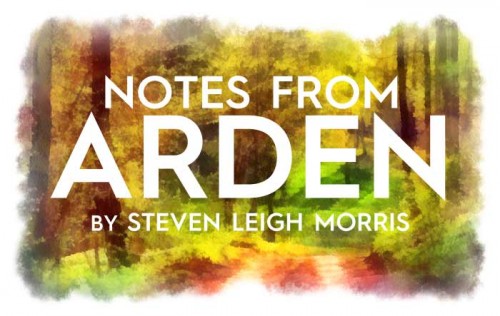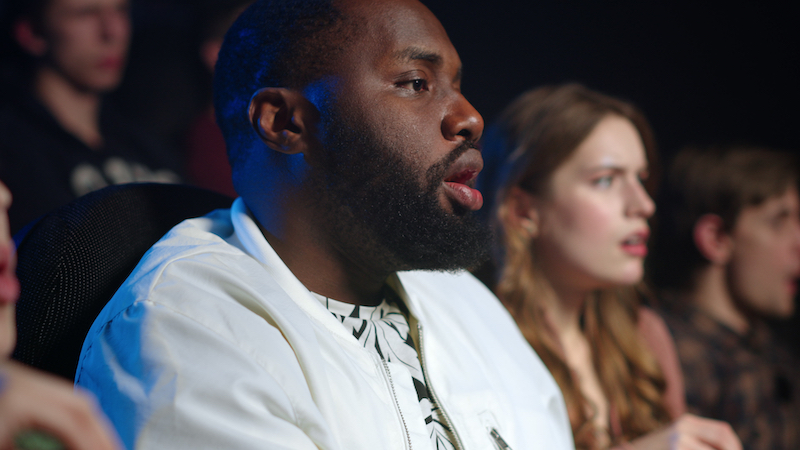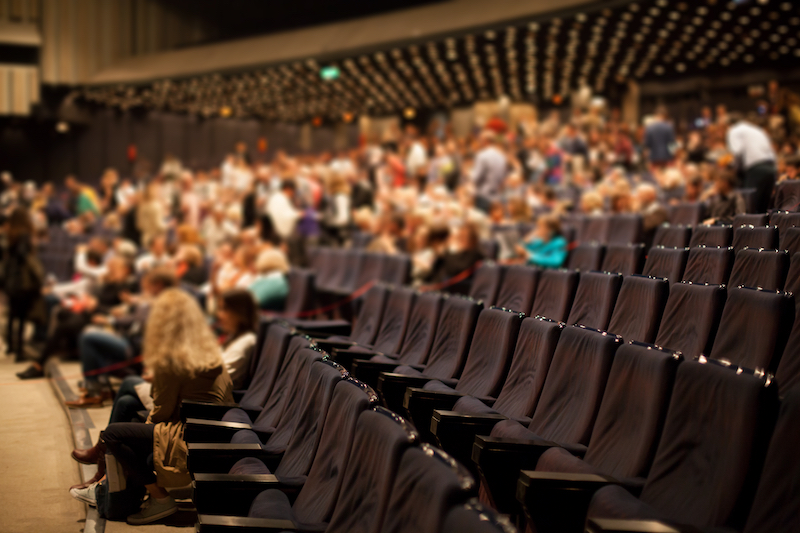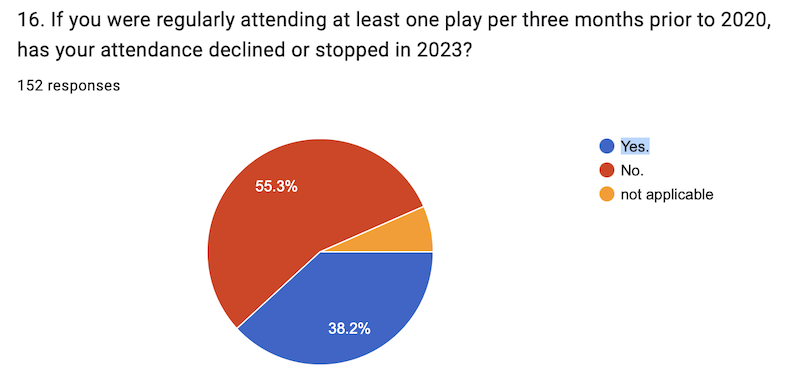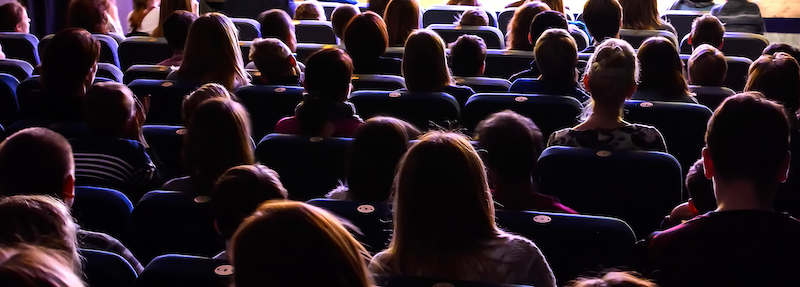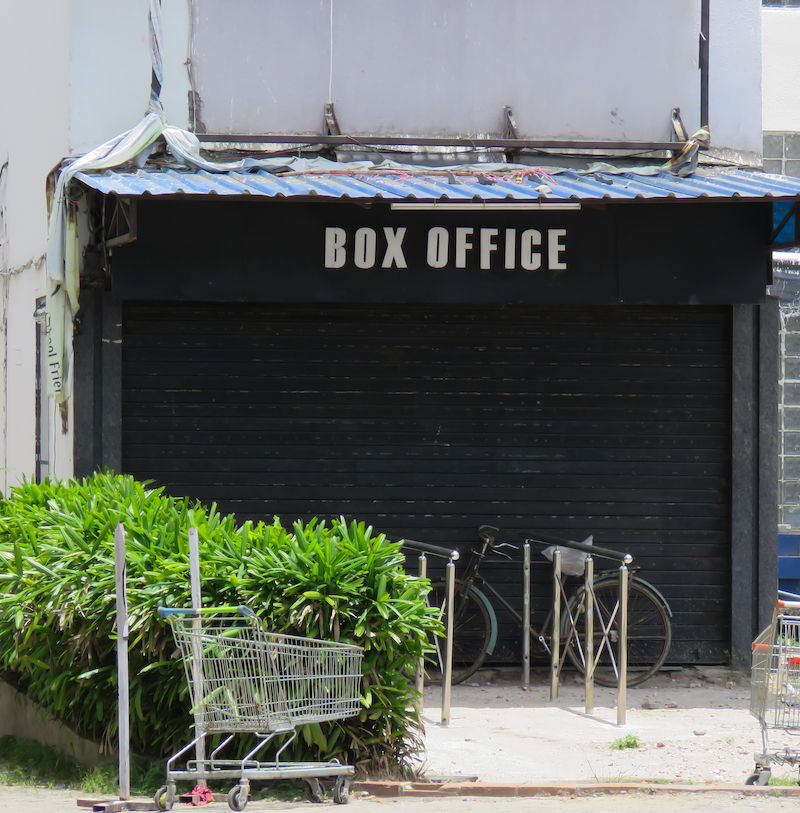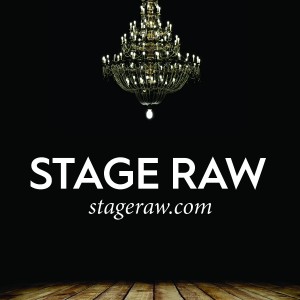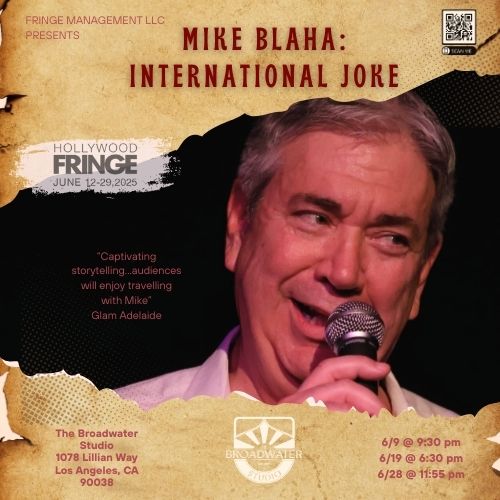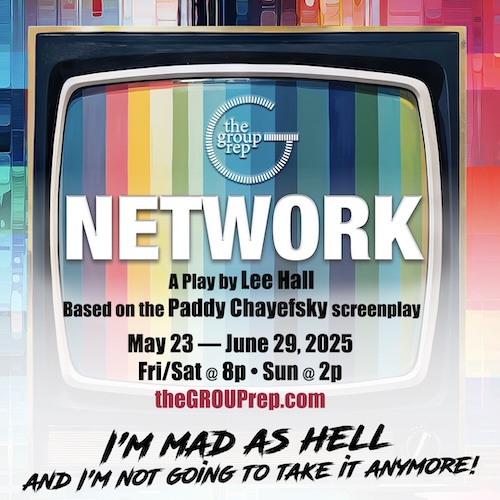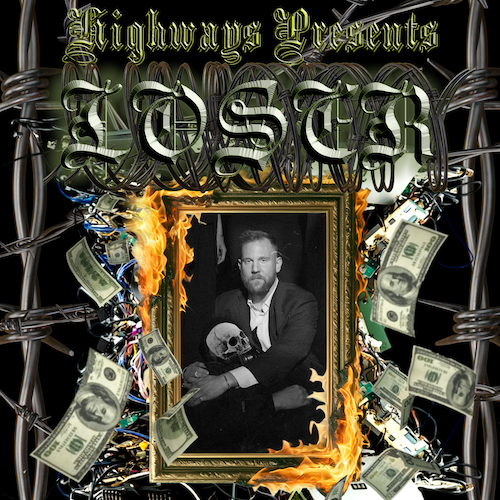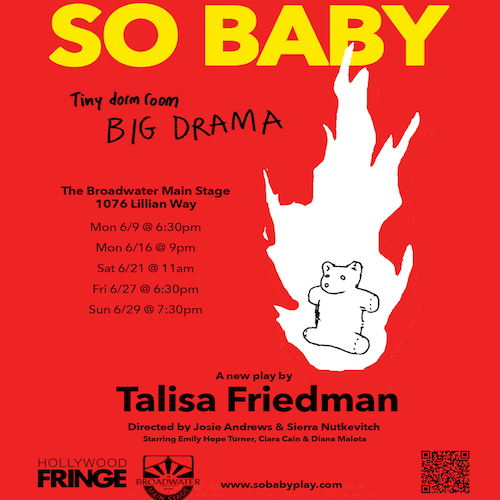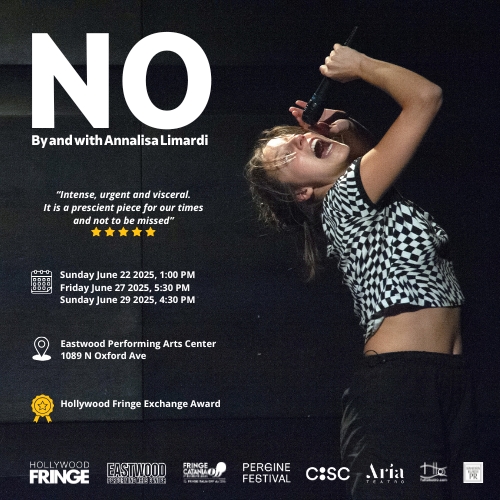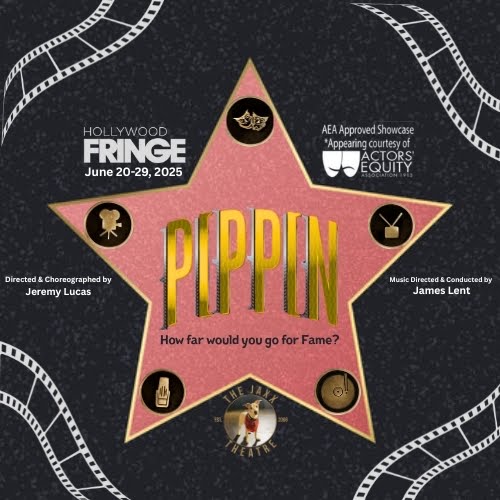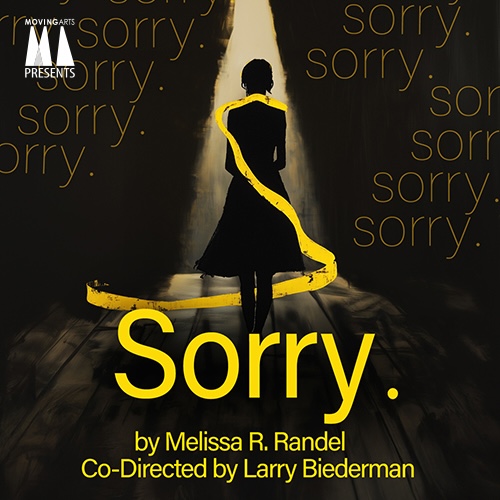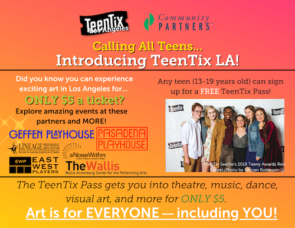
The People Have Spoken, Part 2
Ethnicity, and Audience Attitudes
By Steven Leigh Morris
Note: This is Part 2 in a series of articles analyzing data received in surveys from patrons and theaters. Part 1 (Age and Ageism) is here.
Ethnicity
In measuring the ethnic makeup of Southern California theater patrons, 84.2% of respondents reported in as white, 15.8% non-white. This was after solicitations to our BIPOC theaters to share the survey with their constituents. Whether or not this is representative of the ethnic ratio in theater audiences region wide, we don’t know. If it is, in a region with a population that’s well over 50% non-white, our theaters clearly still have work to do, at least they do if they claim to be representing the region’s demographics.
Of the non-white respondents, 9.9% self-identified as Latino; 3.3% as Asian or Asian-American; 2% as African-American; and 0.7% as Native-American.
We did not record mixed-race self-identification, though multiracial identity is growing in the United States in general, and in California in particular. Multiracial identity presents a conundrum for demographers because it tends to blur the very patterns it purports to clarify.
To illustrate the conundrum, at Cal State, Dominguez Hills, where I teach, I asked an 18-year old student (half Turkish and half Latina) how she identifies. She said Latina, because her mom is Latina and she identifies with her mother. Another student, half Vietnamese and half African-American, said she identifies as both. The confusion that such random identification would create in any demographic survey is best articulated in a 2015 report by the Pew Charitable Trust:
“We faced a fundamental and unavoidable methodological challenge: how to define and measure the concept “multiracial” in a public opinion survey context . . . Racial identity is far from a straightforward concept, and when multiple strands of identity come together this has the potential to increase the complexity. An individual’s racial self-identity may take into account a range of factors beyond genealogy, including family ties, physical appearance, culture and how others perceive them. In other words, being multiracial is more than just a straightforward summation of the races in an individual’s family tree.”
Of the 21 theaters that weighed in on our survey, only five reported the demographic makeup of their audiences in percentages. The 16 others indicated that they simply don’t track such data.
Of those five theaters, three were large/midsize venues, and two were intimate (99-seats or fewer), the percentage of white audiences in 2023 ranged from 41% to 77%; Hispanic/LatinX: 9% to 21%; Asian/Pacific Islander: 10% to 46%, and Black: 5%-7%.
There is one unmistakable trend: Even at the “whitest” theaters in the region, the percentages of non-white audiences appears to have risen, modestly, between 2018 and 2023. The largest such shift was at one intimate theater in the San Fernando Valley, which reported a ratio of white to non-white audiences as 90% to 10% in 2018. By 2023, that ratio had shifted: 70% to 30%. One larger organization reported a shift in that white/non-white audience ratio, from 77%/23% in 2018 to 69%/31% in 2023.
Yet most of the reporting from these theaters is at odds with the data collected in Stage Raw’s Patron Survey, where a whopping 84% of patrons identified as white. By contrast, the two theaters we heard from with the largest contingents of white audiences reported those percentages to be 69% and 70%, respectively.
There are two possible explanations for this discrepancy.
First, a mere five theaters providing actual percentages is insufficient to represent the actual ethnic composition of live theater audiences regionwide. We don’t know the demographics of the remaining 16 theaters who responded, so we don’t know whether our Patron Survey or data provided by the theaters is more representative of overall audiences.
Second, it’s possible that non-white patrons were more reluctant to complete the survey than white audiences, creating an artificial statistical tilt towards a white demographic.
Attendance Dropoff: The Covid Effect? Not Entirely
Anecdotally, theaters have told us that audiences “haven’t come back” since the Covid shutdown of 2020. They’re not entirely wrong. 152 local theater patrons responded to Stage Raw’s question that, prior to 2020, if they used to see at least one stage production every three months, has that theater-going habit declined? Though a majority (55.3%) answered “No,” 38.2% answered “Yes” — over one-third. It would seem that’s the pinch that local theaters have been feeling at their box offices.
So let’s get to some of the reasons our patrons say they’re curtailing their theater-going habit. The Patron Survey offered a pot pourri of seven reasons (from ticket prices, to gas prices, to fear of Covid infection). Respondents were not given the option to choose more than one, because we wanted to identify primary reasons for curtailing live theater attendance. There was an option for “Other,” in which patrons could offer their own explanation, or combine reasons if they wanted.
What came in is a pie with many tiny slices of reasons . . .
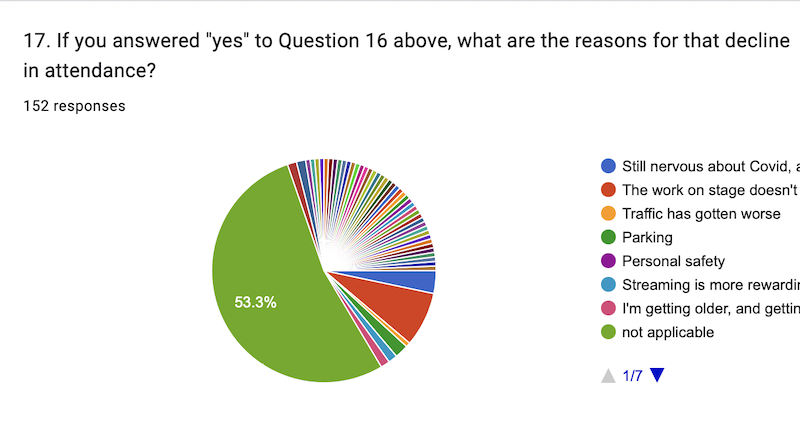 Two observations: The 53.3% who answered “Not Applicable” corresponds quite closely to that majority (55.3%) who say they have not cut back on their theater attendance. But of the seven reasons presented in the survey, most hovered between 1% and 2%. Fear of Covid came in at 3%, followed by Parking (2%), followed by “Streaming is more rewarding” and “I’m getting older and getting to a theater is too taxing” —each of which registered at 1.3%. But the biggest cause cited for cutting back on theater attendance was “The work on stage doesn’t grab me the way it used to,” chiming in at 8%.
Two observations: The 53.3% who answered “Not Applicable” corresponds quite closely to that majority (55.3%) who say they have not cut back on their theater attendance. But of the seven reasons presented in the survey, most hovered between 1% and 2%. Fear of Covid came in at 3%, followed by Parking (2%), followed by “Streaming is more rewarding” and “I’m getting older and getting to a theater is too taxing” —each of which registered at 1.3%. But the biggest cause cited for cutting back on theater attendance was “The work on stage doesn’t grab me the way it used to,” chiming in at 8%.
So let’s take a closer look at these complaints by looking at comments patrons wrote who chose either Option 2 (programming complaint) or “Other.”
The Quality of the Programming (And Other Factors): Patron Comments
-
- All of the above. . . Would be interested in comedies at this point.
-
- I slowed before COVID because I was burnt out on theater and it wasn’t grabbing me. Then I stopped entirely for the pandemic, and haven’t been compelled to go back by anything on offer. (Is anyone going to talk about how the change in Equity rules left small theater in LA limping?)
-
- So much of theater these days tends to be preachy and woke.
-
- High ticket prices to see bad, self-indulgent shows.
-
- It’s not that good
-
- I’m opting to drive less and drive shorter distances. I enjoy spending more time at home watching movies/TV. . . I do think one of the biggest reasons theater has lost audiences is programming plays the theaters believe audiences should see (case in point, the most recent Taper season, much of which I opted not to attend) rather than those audiences want to see.
-
- We went through a collective trauma and isolation in 2020 and there was a time that going to the theater meant risking getting COVID, and for a time that was incredibly dangerous to some of us. When theaters reopened, it felt like no one was acknowledging or addressing what we had just gone through. I kept getting emails that said “Live theater is back!” And I thought “Who cares? I spent the last two years alone AND I almost died.” On top of that, so many of the shows that were being offered meant nothing. And I thought “I’m risking getting COVID for this??” We need shows that tap into what we need now, who we are now. . . We also need shows that bring us together. Get us all excited and talking after the show. Continue the experience after curtain call. We are starving for a communal experience after being isolated for so long . If you’re going to ask someone to risk their life (and that’s what was happening) to come to the theater, then you’d better be giving them a show/experience worth risking their life for . . . Now I want to go to the theater to be elevated, enlightened, connected, and changed.
-
- The quality of work lessened in intimate theater. . . but no one seems willing to differentiate. Everyone is too busy cheerleading to deal with quality issues.
-
- I find myself less receptive to straight plays, revivals, family drama or a play and production team lacking diversity – including all aspects of diversity.
-
- I’m looking to more local options which includes smaller venues and less mainstream. They are producing work that catches my interest. Also it’s difficult to see other shows when you are working on them as well.
-
- The general quality of LA theater has decreased. This is due to rising costs for theaters and also the end of the 99-seat Equity Waiver
-
- The variety of plays had diminished. 1/ The works currently being produced often do not interest us — this is always a continuing situation anyway but there is now less to choose from. 2/ Aside from this wonderful resource, there is a serious lack of a critical community to keep the public informed of what is happening and/or provide information and reviews. I realize this is now a national situation, even in NYC. But it is slowly killing or diminishing and narrowing live theater.
-
- Theater feels “safer” in many respects. The new works being produced aren’t well developed and poignant on specific DEIA initiatives, which is wonderful, but sometimes cringe-worthy to watch.
-
- COVID, and the work doesn’t grab me. A lot of mediocre theater out there and the lockdown made me value my time more.
Complaints about the quality of our theater have been prevalent for the past 30-years at least, along with the boosterism that one patron finds so vexing. I interviewed the now late performance artist Rachel Rosenthal and the now-late critic-playwright Charles Marowitz for the LA Weekly back in the 1990s, and they were saying the same, back then. What has changed, however, are the causes of that perceived mediocrity. The recycled and often doctrinaire “sameness” and “safety” that our current patrons allude to (with just cause) has shifted, due to radically changed economic, cultural, and public health circumstances. What hasn’t changed are the glimmers of artistic brilliance that emerge sporadically across the region. With fewer shows being produced, however, there are fewer such sparks.
Also, among the dust-coated arguments of an earlier era is the one that maintained that there was just too much theater in LA, and that if there were just less of it, the best would survive. This pseudo Darwinian argument stems from the entirely false premise that people with resources necessarily create better theater. Well, less theater is what some people asked for, and they got what they wanted. Sometimes, however, less is just less.
Fewer Viewing Options Due to Fewer Productions: Patron Comments
-
- Fewer productions now, post AB5 and post pandemic.
-
- There aren’t as many shows available to see.
-
- Feels like there’s less and less to see. Wish there were more options of what to see/theaters publicized their shows more.
-
- The theater company that anchored my community has more or less ceased to be, making my relation to the local theater scene more case-by-case than ongoing.
This perception is consistent with Stage Raw’s regional stage listings, which have 40% – 50% fewer offerings per week than 10 years ago.
Ticket Prices, Financial Hardship (And Other Factors): Patron Comments
-
- Loss of Ovation tickets, less discretionary income/pandemic.
-
- Prices are too high for intimate theater. $40 per ticket is as much as a ticket at the Ahmanson or Taper when there are specials. There should be more pay-what-you-can opportunities to lure audiences back to theater.
-
- Too Costly.
-
- Price.
-
- Cost.
-
- Financial circumstances have changed, along with the loss of Ovation tickets. I used to see shows at least once a week, sometimes more. Now, I need a more compelling reason to go, so have become more picky as to what I can spend money to support.
-
- It is more expensive . . . beyond my means.
-
- I do not have extra income to gamble on an unknown play or group.
-
- Tickets are more expensive
-
- Financial difficulties.
-
- Stopped because of 2020 and I haven’t gotten back to attending theater. Lost interest. Need to get reintroduced to/motivated in live theater. Also pricing for small theater has gotten very expensive.
-
- Definitely was still nervous about COVID, but also I feel like prices versus what I have to spend on seeing theater don’t often meet. I feel like I see the most through promotional avenues (under 25 discounts, Professional development/free tix opportunities, tix through work). Unfortunately despite working in theater, theater is still extremely cost prohibitive.
-
- My finances have taken a dive, plus I’m worried about COVID.
It’s striking how the dread of contracting COVID, combined with financial hardship, continues to impact our audiences’ theater-going habits, and the extent to which that shape-shifting virus remains an impediment to the vitality of our theater sector.
Safety Concerns: Patron Comments
-
- Still nervous about Covid, traffic has gotten worse, parking & personal safety.
-
- I don’t have anyone to go with. I will attend certain theaters by myself, but won’t go by myself to theaters in areas where I don’t feel safe
-
- My immunity is compromised and it is difficult to get around.
Lower Priority Than Before: Patron Comments
-
- Wife’s new job makes it difficult to attend plays together.
-
- My job has become much more challenging and stressful since COVID, it is difficult to find time to go.
-
- I haven’t been cast in a play for a number of years for reasons too detailed to list here. I’ve felt alienated by the LA theater community so my enthusiasm to support the community has waned.
-
- I’ve been traveling more which has given me less time and has also been hard on my body.
-
- I think I’ve gotten a little out of the habit.
-
- I retired from my job as an Artistic Director and focusing on my job as a writer.
-
- It’s just lifestyle changes. We just do different things.
-
- My entertainment attention is dominated by client campaigns and my friend’s performances. Prior to the pandemic, event publicity consumed 85-90% of my arts & culture publicity company, so I did see a lot more theater. But during the shutdown, I returned to my roots of music promotion in a big way. As a result, more of my personal and professional attention seems to be consumed by less theatrical productions and more concerts. . .
-
- As a theater agent, I just see less of my clients working in Southern California these days hence I have less things to see. They are working more out in other regions as people have learned to cast off of tape.
The notion that working people struggle to find time to attend theater also is not new. Nor is the proven contention that, if they were exposed to theater as children, the odds are good that they’ll return as theater audiences when they’re older.
The final comment from the theater agent (referenced above) puts a nail in the coffin of that old argument that LA theater is little more than an actor showcase for Hollywood. Which raises the question of what and who, then, is theater actually for, in our digital age? What purposes is it supposed to serve? Is it unique? Can it be a response to our digital age? An antidote?
Next week, we’ll be looking at patron responses to those questions, along with an examination of where and how audiences criss-cross between attending touring Broadway productions and roughing it at a Fringe Festival.
Stage Raw wishes to express its gratitude to Bronwyn Mauldin, Director of Research and Evaluation at the Los Angeles County Department of Arts and Culture, for her notes on this article prior to posting.

